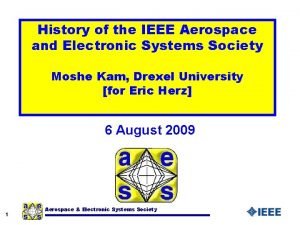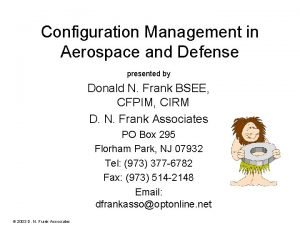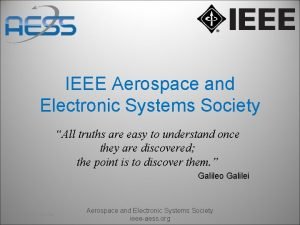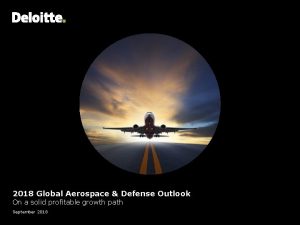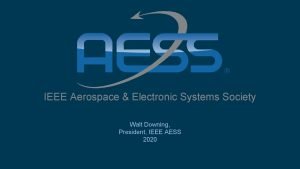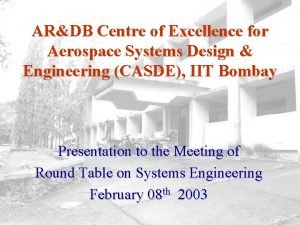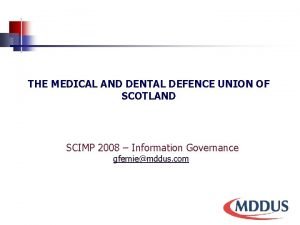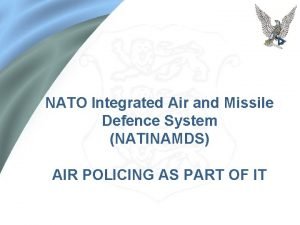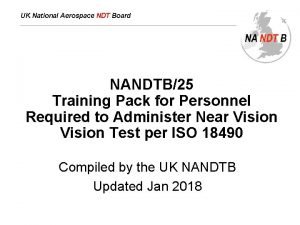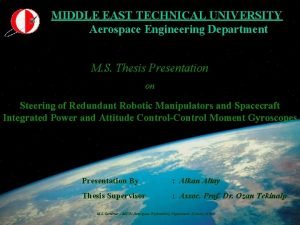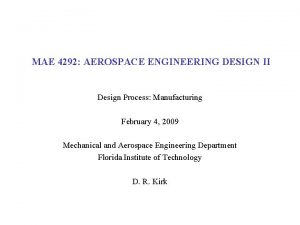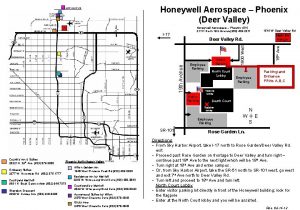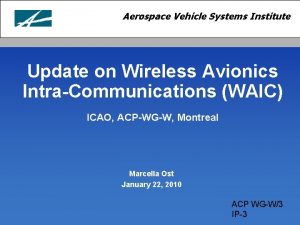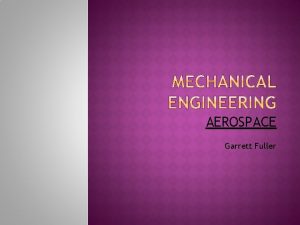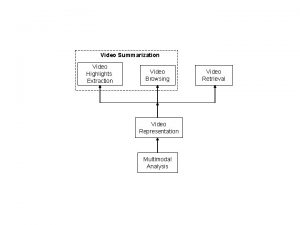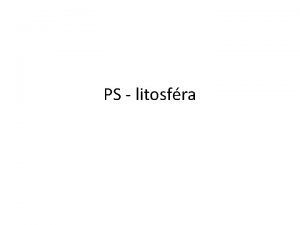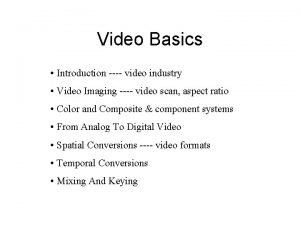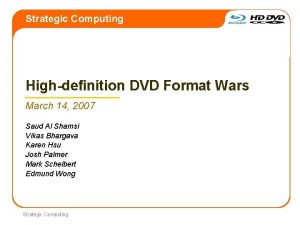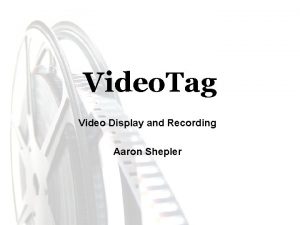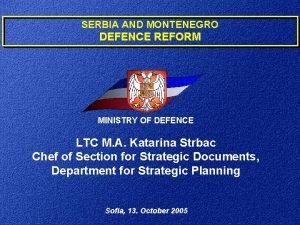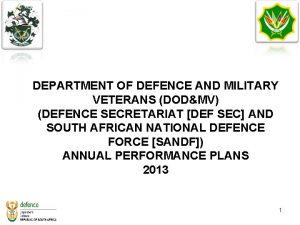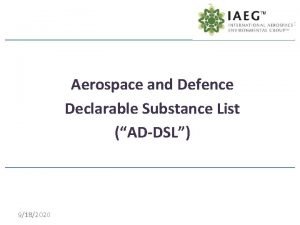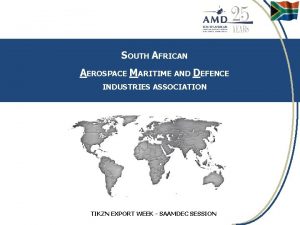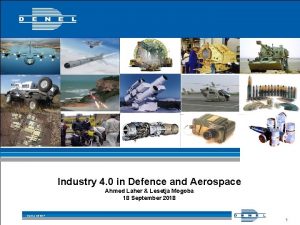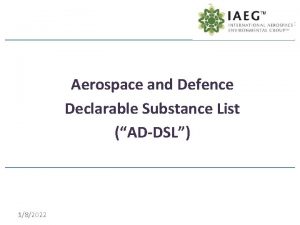Highdefinition video recording in defence and aerospace applications






























- Slides: 30

High-definition video recording in defence and aerospace applications Andrew Haylett 10 th. November 2009

Outline • • • introduction and platforms technology review – analogue and digital ‘hard’ versus ‘soft’ recording video interfaces and metadata raw video bit rates and recording time video compression technologies storage media recording file formats the replay/debrief facility digital video distribution 2

Introduction – the need • acquisition and storage of video signals a key feature of modern defence applications • new sensor/camera technology brings higher resolution images • need to capture complex displays as well as multiple sensors and complex metadata • application areas include training, debrief and forensics • solution must be rugged, cost-effective and scaleable, minimizing size, weight and power 3

Typical platforms • US air: Joint Strike Fighter, P-8 A Poseidon • UK air: Nimrod MRA 4 • US land: Bradley Fighting Vehicle, Abrams Tank, Stryker family • UK land: Warrior armoured vehicle • Many platforms undergoing modernization and capability enhancement 4

Analogue video recording • • mechanical ruggedization a challenge limitations on media capacity and recording time limited video resolution and quality difficult to make acceptable copies vulnerable to electrical interference access is sequential rather than random cannot easily scale to multiple video streams cannot achieve comprehensive data fusion 5

‘Soft’ digital recording ‘soft’ digital recording system: uses graphics card to capture framestore with simple software compression 6

‘Hard’ digital recording uses custom hardware to capture, compress and record multiple video streams 7

‘Soft’ vs. ‘hard’ digital recording Soft recording Hard recording • No extra hardware required • Loads processor/graphics system • Localized; not readily scalable across multiple sources • Focuses on display video capture • Hardware acquisition and compression • Independent of rest of system • Flexible scalable architecture includes entire installation • Captures sensors, displays, metadata 8

Video interfaces Analogue • Composite/RGB TV (NTSC/PAL), including STANAG 3350 • High-resolution analogue RGB – VGA to WUXGA (1920 x 1200) Serial digital • DVI/HDMI • Firewire (IEEE 1394), Camera. Link, USB • SD-SDI, HD-SDI (SMPTE 292 M) • Gig. E Vision – video over Gb. E 9

Metadata and audio Need to capture events or data streams from multiple sources • Operator-initiated signalling of events • Navigational data (GPS) • Time source (IRIG-B) • MIL-STD-1553/1773, Mil. CAN, ARINC 429, Gb. E • Data streams should be reconstituted or stored at debrief station • Recordings should be searchable by metadata • Support multiple audio channels 10

Raw video bit rates Gb. E = 1000 Mbps TV 250 Mbps 110 GB/hour 1400 Mbps 615 GB/hour HD WSXGA 2400 Mbps 1 TB/hour 11

Raw video recording time TV HD WSXGA 140 minutes 25 minutes 15 minutes recording times assuming use of 256 GB memory cartridge 12

Video compression technologies – JPEG • JPEG (ISO/IEC IS 10918 -1), M-JPEG Widely used, performs well for photographic images, suffers from artefacts at high compression • JPEG 2000 (ISO/IEC 15444), Motion JPEG 2000 Improved compression and reduced artefacts, enhanced feature set, adopted by Do. D NITF for highest quality storage 13

Video compression technologies – MPEG • MPEG-2 (ISO/IEC 13818) Widely used in consumer applications including broadcast TV and DVD • MPEG-4 (ISO/IEC 14496) Adds extra coding complexity to deliver improved compression • MPEG-4 Part 10 Advanced Video Coding (ITU H. 264) Used on high-definition DVD; current standard for low bitrate encoding 14

Frame-by-frame vs. inter-frame encoding Intra-frame coding – uses only spatial redundancy I P P Inter-frame coding – uses spatial and temporal redundancy 15

JPEG-2000 vs. MPEG-4 AVC JPEG 2000 MPEG-4 AVC • symmetric: encoding and • asymmetric: decoding M-JPEG 2000 vs. MPEG-4 AVC decoding computationally less computationally demanding • intra-frame coding only • inter- / intra-frame coding • optimum for very high • optimum for medium to resolution images and high-resolution images synthetics • decimation supported • decimation non-optimal • visually or mathematically • visually lossless only lossless 16

Rugged implementations TVJPEG 2000 CC PMC card HD JPEG 2000 AC XMC card 17

Compressed video bit rates Gb. E = 1000 Mbps 12 Mbps 250 Mbps 5. 5 GB/hour 110 GB/hour TV HD 70 Mbps HD 30 GB/hour WSXGA 120 Mbps 50 GB/hour 1400 Mbps 615 GB/hour WSXGA 2400 Mbps 1 TB/hour assuming 20: 1 compression ratio 18

Compressed video recording time TV 140 minutes TV 46 hours HD HD 25 minutes 8 hours WSXGA 15 minutes 5 hours recording times assuming use of 256 GB memory cartridge 19

Storage media – requirements Requirements for military / aerospace applications • mechanically robust • withstand extreme environments: shock, vibration, temperature, humidity • high reliability and long life • maximum storage capacity • easily transportable • security of recorded data 20

Storage media – alternatives Conventional magnetic disks • single units up to 2 TB capacity • need careful system design to protect from environment • not ideal for transport between locations Solid state drives • ruggedisable, transportable, reliable, low mass • available as PCMCIA, Compact. Flash, PCIexpress, Fiber. Channel array up to 5 TB • single rugged unit up to 512 GB capacity 21

Solid-state media PCIexpress storage Compact. Flash module 256 GB removable cartridge 512 GB VPX 3 module 22

Fixed or removable? Fixed • Potentially greater capacity available • Easier to design for rugged environment • Streaming off recorder time-consuming • Problems of security if sensitive data left on platform Removable • Can be swapped during operation if necessary • Convenient to transfer data to debrief station 23

Recording file formats • Common formats include AVI (Windows standard), MPG (MPEG-2/4) – support for video and audio • Ideal format will encompass video, audio and metadata • Open file formats support any video encoding standard; e. g. the Matroska MKV format is codecneutral and allows arbitrary metadata attachments to recorded files • Key design elements are random access with rapid search, jump to event/time 24

Open container file Header Audio 1 Video 1 Audio 2 Video 1 Video 2 Video 1 Video 2 Metadata Audio 1 Metadata Audio 2 25

Replay / debrief facility • Typically based on COTS equipment, e. g. desktop PC • May use software decoder or hardware accelerator depending on compression asymmetry and graphics card capability • Will provide scaled multi-window presentation with jump to arbitrary time and metadata search • Will accept removable media from recording system and optionally support archival to longterm media (e. g. Blu-Ray) 26

Digital video distribution • Video recording and video distribution closely related • Video streams transferred to digital domain may be easily sent point-to-point or broadcast over standard network infrastructure • Video over IP is readily scalable to emerging technologies such as 10 Gb. E • Video recorder becomes node on digital video distribution network • Standard video distribution protocols such as RTP provide quality of service and encapsulation of various compression formats 27

Example architecture video decoder/ display coder Gb. E network switch Gb. E GPS IRIG-B recorder 28

Conclusions Digital video recording offers: • Environmentally robust solution with emphasis on cost, size, weight, power • Enhanced recording time and video quality • Advanced features such as play-while-recording, record only last N hours of mission • Integrates sensor video, display video, audio, events and metadata into single stream • Scalable to high sensor density • Part of comprehensive video distribution system 29

Any questions? Andrew Haylett andrew. haylett@curtisswright. com 01462 472537 30
 Aerospace and defense industries association of europe
Aerospace and defense industries association of europe Aerospace and defense industries association of europe
Aerospace and defense industries association of europe Yandex video b****
Yandex video b**** Yahoo search video
Yahoo search video Videos yahoo search
Videos yahoo search Digital media primer
Digital media primer Transactions on aerospace and electronic systems
Transactions on aerospace and electronic systems Configuration management for aerospace and defense
Configuration management for aerospace and defense Ieee aerospace and electronic systems society
Ieee aerospace and electronic systems society Deloitte global aerospace and defense industry outlook
Deloitte global aerospace and defense industry outlook Walt downing
Walt downing Aerospace systems design and simulation
Aerospace systems design and simulation Dental defence union
Dental defence union Nanosystems in security and defence
Nanosystems in security and defence Defence centre for languages and culture
Defence centre for languages and culture Defence estate and infrastructure group
Defence estate and infrastructure group Natinamds nato
Natinamds nato Tracee martin
Tracee martin National aerospace solutions
National aerospace solutions Pltw aerospace engineering
Pltw aerospace engineering Metu aerospace engineering
Metu aerospace engineering Aerospace design process
Aerospace design process Aerospace engineer spacex salary
Aerospace engineer spacex salary International aerospace quality group
International aerospace quality group Honeywell aerospace phoenix
Honeywell aerospace phoenix How to invest in garuda aerospace
How to invest in garuda aerospace Collins customer portal
Collins customer portal Collins aerospace technical publications
Collins aerospace technical publications Aerospace education foundation badge
Aerospace education foundation badge Aerospace engineering solutions
Aerospace engineering solutions Aerospace vehicle systems institute
Aerospace vehicle systems institute






